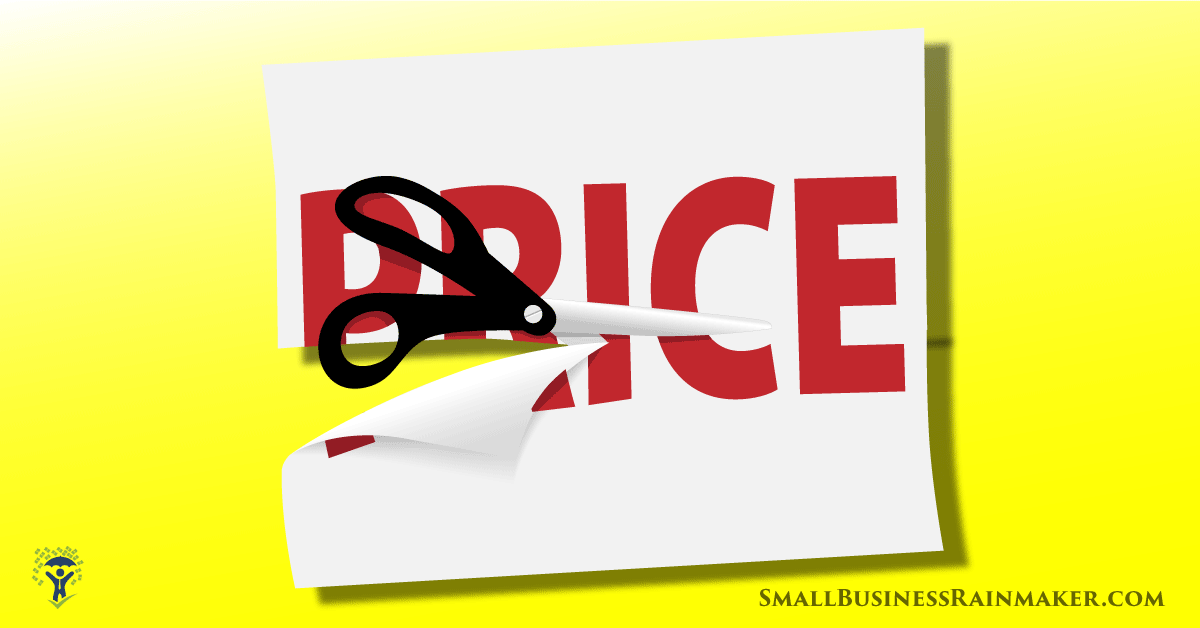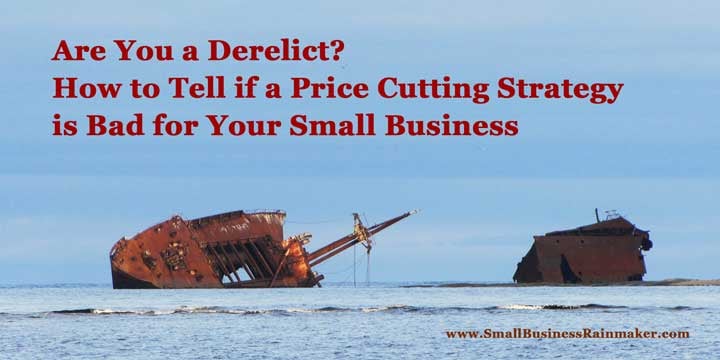
How low can you go? No industry is exempt from intense price competition. A brief scan of business news stories today shows price wars in funerals, beer, airlines, yogurt, gas, Nutella, cell phones, nuts, fast food, and movies.
Despite the well-known perils of price-cutting, it’s a never-ending temptation for businesses big and small. There are plenty of price cutting strategy examples.
- How many low-cost airlines have come and gone?
- Shares of McDonald’s, the fast food franchisor, recently fell when investors felt their discounting strategy had become a “race to the bottom.”
- Another story said price cutting is responsible for torpedoing the shares of the famous camera-maker GoPro.
Price Reduction Strategy Without Price Wars
Nor is this a new story. Here’s an excerpt from an article in Inland Printer Magazine complaining about price-cutting in the printing industry—100 years ago:
“The sea of commerce is thickly studded with hidden rocks, and the business which is being navigated without the chart of experience and the compass of a cost system is very apt to be wrecked along with the reckless, who cut and slash along apparently without a set course. Around these rocks and shoals are strewn many wrecks, while here and there all over the sea we find derelicts whose crews have abandoned them or whose masters have lost control so that they are a menace to navigation.
The printing business seems particularly well supplied with such rock but the greatest danger is in the price-cutting derelicts.
Every once in a while one of these becomes so waterlogged that it goes to the bottom and is out of the way, but while they remain afloat all others sailing that sea are in danger."

A Case of Don’t Follow the Price Cutting Strategy of Big Business
Price wars typically start when there is heavy competition and/or several comparable products available.
Discounting has its place, but for small businesses in particular, it can be an illusory competitive advantage. It doesn't necessarily set the stage for a profitable pricing strategy.
With companies like Amazon and Wal-Mart leading the price-cut charge, it’s tempting for small business owners to follow suit. After all, consumers and business alike are addicted to discounts. And it's easy to simply reduce your product selling price.
The danger in following suit is that you don’t always know what’s going on under the hood.
Price cuts might be a loss leader designed to drive traffic for other products. Or your competitor’s costs might be significantly different than yours. Wal-Mart, for instance, is notorious for getting insane discounts from suppliers to keep their costs low. Small retail shops simply can’t compete with them on price.
Years ago, I managed a small printing company equipped with special presses designed to produce short-run books and manuals. At the time, commercial copiers were getting better and were coming into their own as production machines for our short-run printing work.
Competitors started to try to steal our business with lower pricing. The problem for them was that we could produce a job and make a profit for significantly less than what it cost them to run their copiers.
Do you think that stopped them from underbidding our price? Nope.
They relentlessly ran jobs at less than cost simply to get the work. We didn’t engage in price chopping and eventually the price-cutting "derelict" would disappear. Yet as soon as one sank beneath the waves, two more would appear, ready to sell below cost.
We managed to keep our customers without cutting prices, despite fierce competition. The reasons why had nothing to do with price. I’ll get to that in a minute.

Here’s a second problem with blindly following big business strategy in your small business. An article on small business in the Harvard Business Review says, “A small business is not a little big business.”
Big companies have far more resources than small business. A big company might have money to last through years of a price-cut strategy, whereas a small business could go broke in weeks, even if their product costs are the same.
A big company has departments with many people in each to handle specialized tasks like accounting, marketing, sales, administration, and human resources. A small company might have a single owner who handles almost everything. They can be quickly overwhelmed trying to keep up with a price cutting campaign.
So, is cutting prices a good marketing strategy?
It depends. There are, of course, pros and cons.
Advantages of a Price Reduction Strategy
- It can create a quick burst of sales during slow times.
- It can temporarily improve cash flow.
- It’s a good way to introduce a new product faster, and to a wider audience.
- It’s a simple way to get rid of excess inventory or discontinued items.
- If your business is financially secure, you can use it to drive away competitors, (a.k.a. predatory pricing.)
Disadvantages of a Price Reduction Strategy
- Customers come to expect it, especially if it’s a straightforward price decrease with no other components.
- It creates a disproportionate decrease in profits (see our examples below.)
- It’s more work for the business and it takes longer to recover from mistakes, exchanges, and refunds.
- It can lead to long-term loss of customers and a decline in sales.
- You start to attract the wrong kind of customer—the price shopper.
- It can create a lower perceived value (people think your product is simply worth less)
- It damages your brand. Customers who paid full price could resent your price cuts. Prospects perceive your product as less valuable.
- It’s not a band-aid for systemic problems. For instance, it won’t fix lousy customer service.
- Costs might go up. For instance, if you increase your volume, your miscellaneous variable costs might go up, negating the purpose of the price cut.
- Your competitors might respond with even more price cuts, which can lead to a price war. No one wins.
It’s best to make price-cutting decisions with specific goals in mind. For instance, if you know that as your volume increases your cost per unit decreases, you might plan a price-reduction schedule to coincide with the increase in volume. Perhaps you want to clear excess inventory. If so, have a conversation about whether its necessary. Run the numbers. Do the cons outweigh the pros? Can we sell it all without a price cut? What’s it worth if we write it off? And so on.
The Economics of Price Cutting
The economics of price cutting are startling when you put pen to paper. (It’s even more startling to the business owner when they don’t take time to do this in advance of a discount!)
Here are two price cut examples to illustrate. One is at a 50% margin. The other is at 30%.
Your Regular Price - Sell 10 units @ $100 = $1000, with a gross profit of $500 (Cost = $50/unit or 50% gross margin)
You want to reduce unit price 20% to $80
You need to sell 16.67 units to make the same gross profit.
You want to reduce unit price 25% to $75:
You need to sell 20 units to make the same gross profit.
It's even more dangerous with lower margins:
Your Regular Price - Sell 10 units @ $100 = $1000, with a gross profit of $300 (Cost = $70/unit or 30% gross margin.)
You want to reduce unit price 20% to $80
You need to sell 30 units to make the same gross profit.
You want to reduce unit price 25% to $75
You need to sell 60 units to make the same gross profit.
These two price cutting examples illustrate three important points:
- When we make a price cutting decision in a vacuum, without considering costs, advantages, or disadvantages, we’re making a high-risk decision.
- If your margins are thin, you should avoid long-term price cut tactics.
- It might sound ridiculous to point out the obvious, but I will anyway. Higher margins are better. Don't limit your margins according to best practices or standards in your industry. Figure out ways to increase your margins as much as possible. We have several ways to do that, below.
7 Ways to Avoid Price Wars by Increasing Value
1) Survey Your Customers
I mentioned earlier in my printing company story that we managed to keep customers despite the storm of price reductions going on around us. We did that by increasing value.
One important way to increase value is to get to know in detail everything your customers want. Then go beyond their expectations.
Our printing company competitors didn’t know this, but there were several other things that were equally important as price.
Yes, our customers expected to pay a fair and reasonable price. In addition, they expected to get their complete order of books on time, properly trimmed, printed on the correct stock and most importantly, without missing, blank, or doubled pages. None of our competitors could do all of this with their copiers, no matter what price they billed. To top off the value, we also personally delivered the books and visited the buyer on every order.
2) Bundled Pricing
Bundle two or more related products to get special pricing. This has the added benefit of increasing your average transaction value, too.
3) Additional Services
Add services such as extended tech support or training to current products. In other words, bundle products with services for another way to get discounts and increase the value to both you and the customer. You can also bundle services without products.
4) Minimum Purchases for Discounts
Require minimum purchases for discounted pricing of a single product. For instance, save 5% when you buy 2, 10% when you buy 3, etc.
5) Don’t Neglect Current Customers When Discounting
Pay attention to your existing customers. Let them know you are thinking about them and offer them something that’s not available to new customers. Remind them that they are special, especially when you are doing a price-cutting promotion.
6) Segment Your Customers
Every customer list can be segmented according to how much they’re willing to spend. That number is far bigger than you might believe. We go into more detail here in the related article about pricing and sales. There’s also a nifty calculator you can use to figure this. In short, when you provide more products and services to the top 1-10% of customers, it's easy to outperform a temporary sales increase you might get from price discounting.
7) Start a Free Newsletter
A newsletter, whether printed or email but preferably both, is the best way to keep your customer relationships alive and add incredible value. It’s like doing a regular sales call to every customer without having to send a rep.
Newsletter Marketing Adds Value
If you offer something helpful, educational or of a how-to nature, you are instantly more valuable. Your free newsletter is providing something to make their work or personal life better. Customers, partners, and employees can be great sources of helpful how-to articles.
Newsletters Let Customers Know about Your Special Expertise
There are services, products and benefits you provide that your competitors do not. Even something obvious like geography can be used to your advantage. For instance, you can be the local printer your prospects and customers can come and talk to in person for direct mail marketing advice.
When you keep your expertise front and center with your newsletter, you are set apart from all the rest. It reminds them of the ‘reasons why’ they should start and then continue to do business with you.
Newsletters Provide an Added Level of Customer Service
You can answer customer's technical questions or FAQ's about how your product works or how it could be used. It’s the next best thing to a one-on-one conversation with each of your customers, every month.
Newsletters Keep You Top-of-Mind
A newsletter is a gentle way to remind them why they are buying from you and not your competitor. If you don't remind the customer that you suit them perfectly, they'll conveniently forget this when faced with the inevitable price cutting salesman.
Newsletters Reassure Your Customers that You Will Be There When They Need You
Customers want vendors they can rely on. They know that price cutters disappear without warning. They also know that we’re all in business to make a profit and if you’re going to be around for their next order, you need to make a profit on this one. “Profit” is not the dirty word many would have you believe.
Summary
In short, don’t be a derelict.
First, if you must do a price cut, review your idea thoroughly to ensure it makes sense and fits your company’s goals and culture. Don’t thin your margins so much you can't recover.
Secondly, make yourself price-proof by adding layers of value as we describe above. But don’t stop there. Make yourself irresistible to your customers. It’s a rewarding challenge that will keep you afloat for years to come.
As always, feel free to share your experiences, stories, and suggestions below!
This post was originally published in Feb. 2018 and has been recently updated for accuracy and relevancy.















Leave a comment